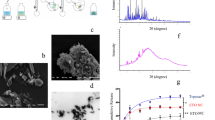Abstract
Purpose. Determine if wet milling technology could be used to formulate water insoluble antitumor agents as stabilized nanocrystalline drug suspensions that retain biological effectiveness following intravenous injection.
Methods. The versatility of the approach is demonstrated by evaluation of four poorly water soluble chemotherapeutic agents that exhibit diverse chemistries and mechanisms of action. The compounds selected were: piposulfan (alkylating agent), etoposide (topoisomerase II inhibitor), camptothecin (topoisomerase I inhibitor) and paclitaxel (antimitotic agent). The agents were wet milled as a 2% w/v solids suspension containing 1 % w/v surfactant stabilizer using a low energy ball mill. The size , physical stability and efficacy of the nanocrystalline suspensions were evaluated.
Results. The data show the feasibility of formulating poorly water soluble anticancer agents as physically stable aqueous nanocrystalline suspensions. The suspensions are physically stable and efficacious following intravenous injection.
Conclusions. Wet milling technology is a feasible approach for formulating poorly water soluble chemotherapeutic agents that may offer a number of advantages over a more classical approach.
Similar content being viewed by others
REFERENCES
J. R. Robinson. Recent advances in formulation of poorly absorbed drugs. In: Current Status on Targeted Drug Delivery to the gastrointestinal tract, pp. 59–63. Capsugel Library, (1993).
J. G. Nairn. Solutions, Emulsions, Suspensions and Extracts. In: A. R. Gennaro (ed.), Remington's Pharmaceutical Sciences, pp.1519–1544. Easton: Mack Publishing Co. (1990).
L. M. Slevin. The clinical pharmacology of etoposide. Cancer, 67:319–329 (1993).
P. Rubin (ed.) Clinical Oncology. Philadelphia: W. B. Saunders (1993).
D. J. O'Dwyer and R. B. Weiss. Hypersensitivity reactions induced by etoposide. Cancer Res, 68:959–961 (1984).
J. M. Bennett, G. H. Lymann, P. A. Cassileth, J. H. Glick, M. M. Okem. A phase II trial of VP-16213 in adults with acute myeloid Leukemia. Am. J. Clinic. Oncol. Cancer Clinical Trials, 7:471–473 (1984).
M. M. Hudson, H. J. Weinstein, S. S. Donaldson, C. Greenwald, L. Kun, N. J. Tarbell, W. A. Humphrey, C. Rupp, N. M. Marina, J. Wilimas, M. P. Link. Acute hypersensitivity reactions to etoposide in a VEPA regimen for Hodgkin's disease. J. Clin. Oncol., 11:1080–1084 (1993).
T. M. Allen. Long circulating (sterically stabilized) liposomes for targeted drug delivery. TIPS, 15:215–220 (1994).
D. Lasic. Applications of liposomes in pharmacology and medicine. In: Liposomes from physics to applications, pp. 262–471. Amsterdam: Elsevier Press (1993).
S. S. Davis, C. Washington, P. West, L. Illum, G. G. Liversidge, L. Sternson, R. Kirsh. Lipid emulsions as drug delivery systems. Ann N.Y. Acad. Sci. 507:76–78 (1987b).
B. Sjostrom, B. Bergenstahl, B. Kronberg. A method for the preparation of submicron particles of sparingly water-soluble drugs by precipitation in oil-in-water emulsions. II: Influence of the emulsifier, the solvent, and the drug substance. J. Pharm. Sci. 82:584–589 (1993).
P. Couvreur, L. Roblot-Treupel, M. F. Poupon, F. Brasseur, F. Puisieux. Nanoparticles as microcarriers for anticancer drugs. Adv. Drug Delivery Rev., 5:209–230 (1990).
R. H. Muller. In: Colloidal carriers for controlled drug delivery and targeting. Stuttgart: Wissenschaftliche (1991).
G. G. Liversidge and K. C. Cundy. Particle size reduction for improvement of oral bioavailability of hyrophobic drugs: I. Absolute oral bioavailability of nanocrystalline danazol in beagle dogs. Int J. Pharm (1995, in press).
N. Kondo, T. Iwao, H. Masuda, K. Yamamouchi, Y. Ishihara, N. Yamada, T. Haga, Y. Ogawa, K. Yokoyama. Improved Oral Absorption of a Poorly Water-Soluble Drug, HO-221, by Wet-Bead Milling Producing Particles in Submicron Region. Chem. Pharm. Bull. 41:737–740 (1993).
T. H. Corbett, D. P. Griswold, B. J. Roberts, J. C. Peckham, F. M. Schable. Biology and therapeutic response of a mouse mammary adenocarcinoma (16/C) and its potential as a model for surgical adjuvant chemotherapy. Cancer Treat. Reports, 62:1471–1488 (1978).
J. L. Grem, K. D. Tutsch, K. J. Simon, D. B. Alberti, J. K. V. Wilson, D. C. Tormey. Phase I study of taxolol administered as a short i.v. infusion daily for 5 days. Cancer Treat. Rep. 71:1179–1184 (1987).
J. Koeller, T. Brown, K. Havlin, J. Craig, D. D. Von Hoff. A phase I study of taxol given as a 6 hour infusion every 21 days. Invest. New Drug 7:451(1989).
D. M. Peereboom, R. C. Donehower, E. A. Eisenhauer, W. P. McGuire, W. P., N. Onetto, J. L. Hubbard. Successful re-treatment with taxol after hypersensitivity reactions. J. Clin. Oncol., 11:885–890 (1993).
N. A. Nelson, R. W. Talley, M. L. Reed, A. M. Evans, B. L. Isaacs, P. Huffman, J. Lousi. Midwest cooperative group evaluation of piposulfan (A-20968) in cancer. Cancer Clin. Pharm. Ther. 8:385–391 (1967).
J. J. Van Dyk, G. Falkson, H. C. Falkson. Clinical experience with 1,4-dihyracryloylpiperazine dimethanesulfonate (NSC-47774). Cancer Chem. Rep. 52:275–286 (1968).
F. M. Muggia, P. J. Creavan, H. H. Hansen, M. H. Cohen, H., O. S. Selawry. Phase I clinical trial of weekly and daily treatment with camptothecin (NSC-100880): Correlation with Preclinical Studies. Cancer Chem. Rep. 56:515–521 (1972).
W. J. Slichenmyer, E. K. Rowinsky, R. C. Donehower, S. H. Kaufmann. The current status of camptothecin analogues as antitumor agents. J. Natl. Cancer Inst. 85:271–291(1993).
K. C. Nicolau, C. Reimer, M. A. Kerr, D. Rideout, W. Wrasidio. Design, synthesis, and biological activity of protaxols. Nature 364:464–466 (1993).
I. A. Darwish, A. T. Florence, A. M. Saleh. Effects of hydrotropic agents on the solubility, precipitation and protein binding of etoposide. J. Pharm. Sci. 78:577–588 (1989).
G. Borchard, J. Kreuter. Interaction of serum components with poly(methylmethacrylate) nanoparticles and the resulting body distribution after intravenous injection in rats. J. Drug Targeting 1:15–19 (1993).
S. E. Dunn, A. Brindley, S. S. Davis, M. C. Davies, L. Illum. Polystyrene-poly(ethylene glycol) PS-PEG 2000 particles as model systems for site specific drug delivery: The effect of PEG surface density on the in vitro cell interactions and in vivo biodistribution. Pharm. Res., 11:1016–1022 (1994).
R. Gref, Y. Minamitake, M. T. Peracchia, V. Trubetskoy, V. Torchilin, R. Langer. Biodegradable long-circulating polymeric nanospheres. Science 263:1600–1603 (1994).
Author information
Authors and Affiliations
Rights and permissions
About this article
Cite this article
Merisko-Liversidge, E., Sarpotdar, P., Bruno, J. et al. Formulation and Antitumor Activity Evaluation of Nanocrystalline Suspensions of Poorly Soluble Anticancer Drugs. Pharm Res 13, 272–278 (1996). https://doi.org/10.1023/A:1016051316815
Issue Date:
DOI: https://doi.org/10.1023/A:1016051316815




